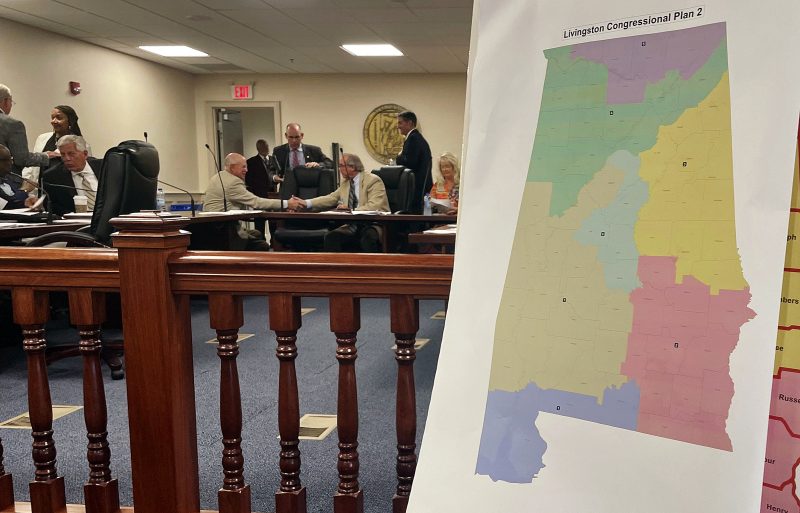The Supreme Court’s order Tuesday clearing the way for a second Alabama congressional district empowering Black voters provides Democrats a prime pickup opportunity for 2024 and is one among an expected flurry of legal rulings with the potential to shape the balance of power on Capitol Hill.
Just months before primary season begins, judges in an unusually large number of states — about a dozen — are weighing the legality of congressional maps. The cases in federal and state courts reflect a pushback against aggressive gerrymandering — much of it in states controlled by Republicans. Most of the cases would, if successful, give Democrats an opportunity to gain seats where they will be favored to win.
Almost all of the challenges began as soon as states drew maps in the once-a-decade process that followed the 2020 Census. But there is renewed vigor to the legal battles after two Supreme Court decisions in June: one enforcing the role courts may play in policing partisan map drawing and the other reaffirming the vitality of the Voting Rights Act in making sure minority voters have the opportunities to elect candidates of their choice.
Analysts agree the stakes in the current challenges are high because the margin for control of the House of Representatives is so slight.
“In a closely divided political landscape, the deciding factor could be what courts end up doing,” said Michael Li, senior counsel at the liberal Brennan Center for Justice at New York University.
That’s partly because gerrymandering and polarization have left so few competitive congressional districts, he said. “There aren’t many opportunities. So the ability to pick up a seat — or even have a shot at winning a seat — can make all the difference in whether Speaker [Kevin] McCarthy keeps the speaker’s gavel or whether Hakeem Jeffries holds it,” Li said, referring to the leaders of the House’s Republican and Democratic caucuses.
There are currently 221 Republicans and 212 Democrats in the House, with two vacancies.
A shift of only one or two seats from the court cases seems a best-case outcome for Republicans, analysts said. Democrats are hoping for enough favorable districts to retake the House.
The fight in Alabama that required Supreme Court intervention this week for a third time could indicate where other states are headed — at least in the South.
The likely result of the new Alabama map, which will be imposed by a three-judge panel after the legislature declined to draw a map that met the Supreme Court’s requirements, would give the state a second congressional district in which Black voters are at or near a majority. Democrats would be strongly favored in that district. Currently, the state has one Democrat — from a predominantly minority district that the federal courts previously required the state to draw — and six White Republican representatives.
A panel of Alabama judges had ruled this month that the legislature’s proposed map represented an unlawful attempt to diminish the power of the state’s Black voters. The Supreme Court had already rejected an earlier version of the state’s map on the same grounds, and on Tuesday threw out Alabama’s latest challenge.
That order was celebrated by voting rights advocates. “These shameful, odious efforts to diminish the rightful voting power of Black Alabamians have finally been defeated,” said Eric H. Holder Jr., attorney general during the Obama administration. “As a result, we will see more representative maps in places that were once thought to be unreachable in the fight for fairness: Alabama, Louisiana, and Georgia.”
Federal courts in Louisiana and Georgia have signaled they are likely to follow the lead of the Alabama rulings, implementing new “opportunity” districts that Republican legislatures denied.
Other challenges stretch from Utah to New York, in federal and state courts, and include charges not only of denying minority voters their fair share of power but also of imposing extreme partisan gerrymanders.
States must draw new political lines after each census to ensure congressional districts have roughly equal populations. How they draw the lines often helps determine which political party has an advantage, and intense legal battles develop in each redistricting cycle. When lines are drawn to favor one party or the other — or to enhance the power of some voters at the expense of others — that’s known as gerrymandering.
Ilya Shapiro, director of constitutional studies at the conservative Manhattan Institute for Policy Research, said litigation often persists for years after each census because Democrats and Republicans alike want to maximize their opportunities. The litigation is especially pivotal in this election cycle.
“Typically you don’t have a House majority that’s so narrow,” he said. “Any number of things could flip those five seats, make that five-seat difference. … One or two seats here or there quickly becomes one of those things that can affect the overall majority.”
It’s unusual for so much litigation challenging alleged gerrymanders of congressional districts to be ongoing three years after the census. A dozen states are now involved in ongoing lawsuits over congressional lines, compared with four states that were involved in such litigation as of July 2013, according to Justin Levitt, a Loyola Law School professor who closely tracks redistricting cases.
Litigation over state legislative lines is comparable to what it was 10 years ago, with 14 states in such legal battles now compared to 13 as of July 2013. More litigation could still come; in the last redistricting cycle, some lawsuits were not filed until over three years after the census.
The increase in long-running congressional cases stems from a few factors, Levitt said. For decades under the Voting Rights Act, states with a history of racial discrimination were required to get permission from a court or the Justice Department before changing election policies. The Supreme Court invalidated that part of the Voting Rights Act in 2013, emboldening some states to engage in more aggressive redistricting that resulted in lawsuits, Levitt said.
In addition, the Supreme Court in 2019 ruled that federal courts had no role to play in policing maps drawn by legislatures to gain partisan advantage. Some states took that as a license to design more extreme maps, which in turn prompted a spate of lawsuits in state courts that can still consider partisan gerrymandering cases.
Meanwhile, some lawsuits faced delays while lower courts waited for the Supreme Court to decide the Alabama case and a redistricting lawsuit out of North Carolina.
In the North Carolina case, Republican state lawmakers argued state courts could not review their congressional redistricting plans. In a 6-3 decision, the Supreme Court rejected the GOP lawmakers’ arguments and the most extreme version of what’s known as the independent state legislature theory.
Once the court released the Alabama and North Carolina decisions in June, litigation in other states that had been on hold resumed. Now, those cases are advancing as Republicans and Democrats gear up for the 2024 election, which includes congressional primaries as early as March.
Litigation in New York provides some of the biggest hopes for Democrats, who recently won an appeals court ruling that found new maps must be drawn for next year.
Democrats who control the state legislature drew maps that favor their party after the 2020 Census. But the state’s top court found they violated the state constitution’s ban on partisan gerrymandering. The court turned map-drawing duties over to a neutral expert, and under those maps last year, Democrats won 15 House seats and Republicans won 11.
After the election, Democrats brought a new lawsuit arguing the maps used in 2022 were meant to be temporary and new ones should be drawn. An appeals court in July sided with the Democrats, and the state Supreme Court is now considering the matter.
John Faso, a former New York congressman who is advising fellow Republicans involved in the case, said time is running out to redraw the maps without confusing voters. “It will be mass chaos,” he said.
Republicans, meanwhile, are poised to gain seats in North Carolina. The state’s high court last year said the congressional map violated the state’s constitution, and implemented a one-time-only congressional map for 2022. Under maps drawn by a special master, Republicans and Democrats evenly split the state’s 14 congressional districts.
But Republicans have since gained control of the North Carolina Supreme Court, which has reversed its precedent. Republican lawmakers will soon draw new maps for 2024 and could reimpose the map that experts said could give the GOP 10 congressional seats.
As in New York and North Carolina, litigation in Utah centers on accusations of partisan gerrymandering. There, the League of Women Voters sued after state lawmakers ignored the recommendations of an independent redistricting commission.
Litigation in Georgia, Louisiana, South Carolina and Florida relates to allegations of racial gerrymandering. Next month, for instance, the Supreme Court will consider South Carolina’s attempt to reinstate a congressional redistricting plan that a lower court found had “exiled” 30,000 Black voters to create a district safer for a White Republican candidate.
The Supreme Court’s June decision in the Alabama case, Allen v. Milligan, could be key in some of those cases, lawyers said. The court in that 5-4 ruling reaffirmed Voting Rights Act protections of the rights of minority voters to elect candidates of their choice.
“That reaffirmation in some sense is kind of unremarkable: The law exists as it always has for the last 37 years,” said Abha Khanna, a Seattle-based attorney involved in many of the challenges of congressional maps drawn by Republican-led state legislatures, including Alabama’s. “But it also was exactly what was needed to stave off so many of these states’ efforts to shrug off the obligations of the Voting Rights Act.”
Because of polarized voting patterns, so-called majority-minority congressional districts are almost always won by Democrats. But, Khanna said, the cases should not be seen as partisan battles or an attempt by Democrats to use the courts for advantage.
“If anything, we are fighting against maps that are drawn to dictate a certain outcome before any ballots are cast,” she said. “We’re actually trying to change it so that there is a choice, or an opportunity for a choice by Black voters.”
Adam Kincaid, the executive director of the National Republican Redistricting Trust, said the redistricting cases nationwide will take months to resolve and could head in unpredictable directions.
“At the end of the day, when all of these different cases play through and everything plays out over the next few months, I think we’re getting pretty close to where we are now,” Kincaid said. “There’s a long way to go before we know what the election looks like next year.”


































